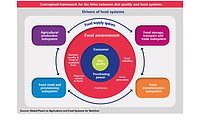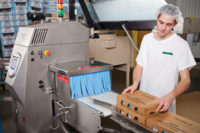When you pick up a plastic-wrapped package in a grocery store and can’t read everything on the label because of a reflection or crease, you probably turn or tilt the package until the lighting is just right. If only it were that easy for machine vision systems.
With them, finding the right amount of light or the right angle to get a clear image without shiny surface reflections has always been tricky. But, KEYENCE Corporation of America (Itasca, IL) worked on this problem; came up with a solution; and received an award for it.
This past March, the company’s LumiTrax machine vision lighting technology was recognized among the best in the industry by the judges of the Vision Systems Design 2015 Innovators Awards Program. What makes the technology special is its ability to counter the ever-varying reflections and distortions shrink wrap causes to text laying underneath it. The result? High-quality, stable images for easy, reliable and consistent machine vision processing.
FE caught up with James Gardner, KEYENCE senior manager, application development group, machine vision technology, to find out more about this technology. As part of the company’s US product creation team, Gardner played a key role in its development.
FE: Can you explain some of the issues in machine vision applications?
James Gardner: The key challenge is getting a consistent, decent image—clearly defining the feature for inspection versus the background. Other challenges include accommodating and accounting for variation, which can come from a range of parts, changes in their presentation and changes in the ambient environment. A good image is at the heart of a good machine vision setup.
FE: LumiTrax technology includes high-speed cameras, intelligent lighting and algorithms. Can you explain the thought process behind this combined solution?
Gardner: We started with the problems every user of machine vision has faced: image consistency and stable extraction of the feature versus the background. Essentially, we had two-thirds of the solution [high-speed cameras and algorithms] on our XG and CVX series platforms. We recognized machine vision is like a house of cards: Everything is stacked on the image.
FE: How does this solution work?
Gardner: It works on the concept of taking multiple images, using a different segment of the light each time. Each segment produces a slightly different image, where the shadow from the structure of the target changes, yet the underlying detail remains the same. Using the varying and constant elements in the series of images allows us to build a final image, where either the features are extracted from the background based on a structural change, or the variable aspects (such as hot spots) are removed.
FE: How long was this in development?
Gardner: At KEYENCE, we pride ourselves on the continual development of our products and bringing new, innovative technologies to the market; it’s a big part of what we do. LumiTrax technology is one of many new developments we have brought to machine vision in the last couple of years. These include quick and easy, vision-guided robotics, auto-teach inspection, combined 2D and 3D inspection, auto/manual generation, 21-megapixel color and grayscale cameras, and wavelength convertor backlight.
FE: How do you build in extra speed to do all the computations required to get on-time inspection results for packaging lines?
Gardner: The key to meeting industry speed requirements is our hardware design. LumiTrax technology was developed as a hardware solution, rather than a software solution, to minimize processing overheads. Because of the multi-imaging method used, the LumiTrax hardware maximizes high-speed image acquisition.
In addition, the CVX and XG vision controllers are specifically designed for industrial machine vision with our 3+1 processor architecture. The four processors allocate specific tasks, which are run in parallel. Couple these pieces of hardware with ample image memory, and meeting inspection requirements is not a problem.
FE: What is the range of line speeds this technology can handle?
Gardner: LumiTrax technology is ideal for high-speed production, and its performance typically surpasses conventional machine vision systems. The LumiTrax light is approximately three times brighter than a standard ring light, and the camera features a high-speed CMOS sensor. Both of these are important aspects of the LumiTrax technology. How well a vision system works on a production line is a factor of the time it takes to acquire an image and how the processing of that image is handled.
LumiTrax technology allows for a faster exposure time [default ranges from 0.2 ms to 2 ms (depending on the camera)] than a conventional system. Both the CVX and XG controllers buffer images, so once an image has been transferred, the camera is free to take the next one. The transfer times range from 1.7 ms [VGA] to 29 ms [5 MP].
With a VGA camera, the total time to “build” the image is 13.4 ms. As the image processing is being handled by the DSPs in the controller, the camera is free to start the acquisition of the next part. The 13.4 ms equates to 4,477 parts per minute.
Conventional vision systems are designed on a single processor and must wait until the current image has been processed before being able to acquire the next. This means their tool processing time must be added to the image acquisition time to determine their parts per minute processing capability.
For comparison purposes, a conventional system might achieve something like 1,000 parts per minute [5 ms exposure time, 4.7 ms transfer speed, 50 ms tool processing time = 59.7 ms total time].
FE: In what other vision applications could this technology be applied?
Gardner: It is a far-reaching technology, in that it not only helps stabilize against issues such as hot spots and ambient light, it also extracts features from backgrounds based on structure. The technology opens up new ways to solve application problems and provide for those which have been previously impossible or near impossible to solve, such as defect detection on graphical surfaces; embossed and stamped serial number reading; the stable processing of targets with high variance in surface color, finish and appearance; and low-to-no contrast feature recognition and detection. Combining this technology with the CVX and XG systems provides a full range of machine vision tools for a variety of automated, identification, process control and monitoring applications.
FE: Is LumiTrax technology standard with KEYENCE machine vision systems?
Gardner: At the heart of our machine vision design is flexibility, so we offer a modular system. Different cameras and lighting options [CVX or XG] can be combined on the same hardware platform. The LumiTrax technology is optional, but it is pretty much becoming the standard, go-to lighting technology for front-lit machine vision applications, due to the image stability and feature extraction functionality it offers.





